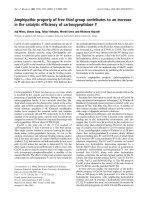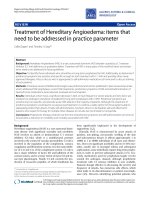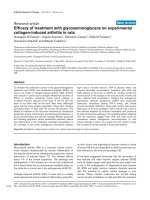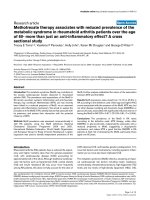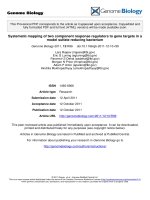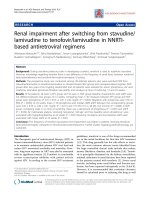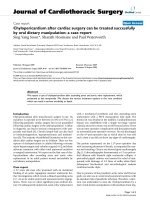Báo cáo y học: " Mannose-binding lectin deficiency with eosinophilic meningoencephalitis due to Angiostrongylus cantonensis in children: a case series" pot
Bạn đang xem bản rút gọn của tài liệu. Xem và tải ngay bản đầy đủ của tài liệu tại đây (288.76 KB, 5 trang )
CASE REP O R T Open Access
Mannose-binding lectin deficiency with
eosinophilic meningoencephalitis due to
Angiostrongylus cantonensis in children: a case
series
Bárbara Padilla-Docal
1
, Alberto J Dorta-Contreras
1
, Raisa Bu-Coifiu-Fanego
1
, René H Martínez-Alderete
1
,
Olga Susana de Paula-Almeida
1
, Hansotto Reiber
2
and Jens Christian Jensenius
3*
Abstract
Introduction: Eosinophilic meningitis, a potentially fatal disease caused by Angiostrongylus cantonensis,is
considered an emerging infectious disease.
Case presentation: Three Caucasian boys (aged five-years-old, 10-years-old and six-years-old) with a diagnosis of
eosinophilic meningoencephalitis caused by Angiostrongylus cantonensis were studied. Serum immunoglobulin A
(IgA), IgM, IgG, and complements C3c and C4 levels were quantified by using an immunodiffusion technique.
Immunoglobulin E in serum was quantified by nephelometry and mannose-binding lectin by time-resolved
fluorometry. Mannose-binding lectin deficiency was observed in the three patients. The first patient showed a
reduction in the levels of IgA and IgM and an increase in the values of IgE and C4. The second patient showed a
reduction in mannose-binding lectin level with increased IgG, C4 and IgE levels, and the third patient showed a
decrease in mannose-binding lectin level and increased levels of IgM and complement C3c as well as a low level
of C4.
Conclusions: To the best of our knowledge, this is the first report of mannose-binding lectin deficiency associated
with Angiostrongylus cantonensis meningoencephalitis in children, and it may contribute to the understanding of
the participation of this component of the lectin pathway in the development of the disease.
Introduction
Eosinophilic meningitis, a potentially fatal disease caused
by Angiostrongylus cantonensis, a parasitic nematode, is
considered an emerging infectious disease [1]. Adult A.
cantone nsis live in the pulmonary arteries of its definitive
hosts, that is, rodents, especially rats, which pass infective
first-stage larvae (L1) in their feces. The life cycle also
involves mollusks harboring larval stages. In humans, lar-
vae fail to mature, and hence humans and their excreta
play no role in the transmission and direct dissemination
of the parasite. Humans become infected by ingesting
third-sta ge larvae (L3) in raw or undercoo ked intermedi-
ate host mollusks (for example, snails and slugs) or
paratenic hosts (for example, freshwater prawns, crabs,
frogs and fish) [1]. Lettuce and vegetable juice have also
been identified as sources ofinfectionwhencontami-
nated with intermediate or paratenic hosts [1].
The complement system provides an important effec-
tor mechanism of innate immune defense. Activatio n of
the complement system proceeds through three different
pathways converging in the activation of complement
C3. The classical pathway is typically initiated after anti-
gen recognition b y antibodies, the alternative pathway
relies on interference by foreign substances in a delicate
activation-inhibition balance and the third pathway, the
mannan-binding lectin (MBL) or lectin pathway, is
initiated when one of the molecules MBL, L-ficolin or
H-ficolin recognizes ligands arranged in patterns charac-
teristic of microbial surfaces, pathogen-associated
* Correspondence:
3
Department of Medical Microbiology and Immunology, University of
Aarhus, Aarhus, Denmark
Full list of author information is available at the end of the article
Padilla-Docal et al. Journal of Medical Case Reports 2011, 5:330
/>JOURNAL OF MEDICAL
CASE REPORTS
© 2011 Padilla-Docal et al; licensee BioMed Central Ltd. This is an Open Access article distributed under the terms of the Creative
Commons Attribution License ( nses/by/2.0), which permits unrestricted use, distribution, and
reproduction in any medium, provided the original work is properly cited.
molecular patterns or pathogen-associated molecular
patterns [2].
The objective of the present paper is to present the
association between MBL defic iency and meningoence-
phalitis due to Angiostrongylus cantonensis in three chil-
dren. The resear ch project was approved by the hospita l
ethical committee, and the written informed consent of
each parent or guardian was obtained.
Case presentations
Case 1 is a five-year-old Caucasian Cuban boy; suffering
from eosinophilic meningoencephalitis caused by
Angiostrongylus Cantonensis was admitted to the hospi-
tal i n May 2005. The clinical and neuroimmunologic al
diagnoses were performed according to the protocol
described in an earlier publication [3]. For all m easure-
ments, aliquo ts of serum were frozen and kept at -20°C
for further analysis.
Serum levels of immunoglobulin A (IgA), IgM and IgG
were quantified by an immunodiffusion technique using
NOR Partigen immunoplates purchased from Siemens
(Marburg, Germany). The levels of IgE in serum were
quantified by N Latex IgE Mono immunoassay in a BN
Prospec nephelometer (Dade Behring). C3c and C4 were
quantified by using an immunodiffusion technique
employing C3c NOR Partigen and C4 NOR Partigen
immunoplates (Siemens). A detailed description of buf-
fers and reagents has been given elsewhere [4]. The assay
is a variant of the assay described by MacDonald et al [5].
In brief; monoclonal anti-MBL antibody was coated on
the s urface of microtiter wells. Plasma samples diluted
in a buffer consisting of 20 mM Tris, 1 M NaCl, 10 mM
CaCl
2
, 0.05% (vol/vol) Triton X-100, 0.1% human serum
albumin (wt/vol), heat-aggregated normal human IgG
(10 mg/ml), 1% (vol/vol) bovine serum albumin, pH 7.4,
was added to the wells. Following incubation, the wells
were washed, and europium-labeled anti-MBL antibody
was added. After another incubation and wash, enhance-
ment buffer was added and the bound europium was
measured by time-resolved fluorometry. Dilutions of a
standard plasma as well as a sample of plasma with
known high (1046 ng of MBL/ml), middle (251 ng of
MBL/ml) and low (38 ng of MBL/ml) concentrations
were included as internal controls. The inter-assay coef-
ficients of variation (%) for the three concentrations cal-
culated on the basis of 20 assays were 8%, 8% and 11%,
respectively [4].
The clinical diagnosis of the illness was fever, vomiting
and irritation, together with a cerebrospinal fluid analy-
sis with the presence of eosinophils and high cellular
countdown in this biological liquid. In Cuba, these char-
acteristics are enough to diagnose this disease because
there is no other agent that produces eosinophils in this
biological fluid [6,7].
The individual conc entrations in blood of the major
immunoglobulins, IgE, C3c, C4 and MBL may be
observed in Table 1. T he values of each of these serum
proteins were contrasted with the normal values
reported for boys in this age group [8]. Normal values
for MBL have been considered in previous reports [2].
He has antecedents of having had other illnesses
before the present disease, such as acute diarrhoea with
a remarkable serum MBL deficiency. At the moment of
the first diagnosis of lumbar puncture, the patient had a
level of glucose/serum of 0.54, which shows that there
was no a bacterial process. In the differential cell count,
the lymphocytes were predominant at 77%, and the pre-
sence of eosinophils in the blood and CSF were typical
for cases of the illness.
At the moment of the first diagnostic lumbar punc-
ture, this patient had a combined IgA and IgM defi-
ciency because of serum levels. On the other hand, his
IgG levels were in the normal range and his IgE and C 4
levels were increased.
According to the normal values that have been
reported for the Cuban population, he showed a reduc-
tion of the values of IgA and IgM and an increase in the
values of IgE and C4. His MBL levels were also reduced.
This patient had only a reduction of MBL levels, and his
C4 and IgE levels were increased. Increased serum IgE
level is compatible with the repo rted presentation in
this type of parasitic infection [9].
This presentation corresponds perfectly with previous
reports in which IgE values were increased in blood in
accord with this illness, where A. cantonensis larvae go
first to the lungs of the patient and later to the brain
throughout the blood [9].
The blood and CSF profiles of this patient are given in
Table 2. The most significant infectious disorders asso-
ciated with MBL def iciency that the patient experienced
were observed in Table 3.
After he lmintic meningoencephalitis, the patient kept
on with a respiratory infection history with possible
remains not related to A. cantonensis previous infection.
Case 2 is a 10-year-old Caucasian Cuban boy; suffer-
ing from eosinophilic meningoencephalitis caused by
Angiostrongylus Cantonensis was admitted to the hospi-
tal in June 2008. The clinical and neuroimmunological
diagnoses were performed according to the protocol
described in an earlier publication [3]. For all m easure-
ments, aliquo ts of serum were frozen and kept at -20°C
for further analysis. Immunoglobulins, C3c, C4 and
MBL in CSF and serum analysis were determined as
case 1.
The clinical diagnosis of the illness was fever, vomiting
and headache, together with a cerebrospinal fluid analy-
sis with the presence of eosinophils and high cellular
countdown in this biological liquid. His concentrations
Padilla-Docal et al. Journal of Medical Case Reports 2011, 5:330
/>Page 2 of 5
in blood of the major immunoglobulins, IgE, C3c, C4
and MBL may be observed in Table 1
This patient had the typical signs and symptoms of a
meningoenceph alitis. It was later diagnosed as eosino-
philia because the high count of these cells in the CSF.
This patient has a CSF/serum glucose q uotient of 0.54,
like a n onbacteria l infection. Ninety percent of lympho-
cytes may be confused with viral meningoencephalitis if
the presence of eosinophils in CSF is taken into account.
As the previous case, this patient is characterized by
having reduced MBL levels. It is compatible with a pri-
mary MBL immunodeficiency.
This patient had previously a recurrent infection that
caused bacterial diarrhoea and some sepsis symptoms as
well as dehidratation. During the illness produced by A.
cantonensis, he had severe brain edema.
This patient showed a redu ctio n of the values of C3c
and an increase in the values of IgG and C4. IgA, IgM
and IgE were normal. These figures are complemented
by an increment of C4 levels. As in case 1, this boy had
an MBL deficiency.
The blood and CSF profiles of this patient are given in
Table2.Table3showsthemost significant infectious
disorders associated with MBL deficiency that the
patient experienced. The clinical features were obtained
from their records.
Case 3 is a six-year-old Caucasian Cuban boy who was
clinically diagnosed with eosinophilic meningoencephali-
tis on the basis of the symptoms typically observed in
this illness, together with serum and CSF eosinophils.
He was admitted to the hospital in May 2009. The clini-
cal and neuroimmunological diagnoses w ere performed
according to the protocol described in an earlier publi-
cation [3]. For all measurements, aliquots of serum were
frozen and kept at -20°C for further analysis. Immuno-
globulins, C3c, C4 and MBL in CSF and serum analysis
were determined as case 1.
The clinical diagnosis of the illness was fever, vomiting
and headache, together with a cerebrospinal fluid analy-
sis with the presence of eosinophils and high cellular
countdown i n this biological liquid. Concentrations in
blood of the major immunoglobulins, IgE, C3c, C4 and
MBL may be observed in Table 1. He had a 0.52 CSF/
serum glucose quotient with 87% lymphocytes.
This patient had a decrement of MBL but combined
with normal IgA, IgG, and C4 values. MBL was found
to be reduced, and his IgM and C3c were increased.
During the acute phase, CSF and blood were taken for
diagnostic purposes.
The increased C3c levels could ensure a t least the
functioning of the alternative pathway and part of the
classical pathway. The increment of IgM values and the
normal IgG values help to fix the complement system.
This patient had had parasitic infections of toxocario-
sis as well as after the eosinophilic meningoencephalitis
Table 1 Serum immunoglobulin, complement components and MBL levels
a
Patient Age,
years
IgA
(g/l)
IgG
(g/l)
IgM
(g/l)
IgE
(IU/ml)
C3c
(g/l)
C4
(g/l)
MBL
1 5 0.32 13.58 1.21 70.6 0.39 0.52 30 ng/ml
Normal
values
3 to 5 0.55-1.52 5.69-15.97 0.22-1 60 0.55-1.2 0.2-0.5 1.5 g/ml
2 10 0.54 20.36 0.93 39.9 0.27 0.59 390 ng/ml
Normal
values
9 to 11 0.12-
2.08
7.79-14.56 0.35-1.32 200 0.55-1.2 0.2-0.5 1.5 g/ml
3 6 1.13 8.15 1.7 n.d. 2.18 0.41 385 ng/ml
Normal
values
6 to 8 0.54-2.21 5.59-14.92 0.27-1.18 90 0.55-1.2 0.2-0.5 1.5 g/ml
a
MBL, mannose-binding lectin; IgA, immunoglobulin A; IgG, immunoglobulin G, IgM, immunoglobulin M; IgE, immunoglobulin E; C3c, complement C3c; C4,
complement C4; n.d., no data.
Table 2 Blood and CSF profiles
Patient Blood
eosinophils,
%
Blood
glucose,
mM/l
CSF cell
count,
10
-6
CSF
eosinophils,
%
CSF
glucose,
mM/l
1 7% 2.35 857 32% 4.33
2 12% 5.9 402 45% 3.2
3 10% 5.9 630 31% 3.1
Normal
rank
a
CSF, cerebrospinal fluid.
Table 3 Clinical features of patients suffering from
Angiostrongylus cantonensis meningoencephalitis with
MBL immunodeficiency
Patient Clinical features
1 Viral diarrhea (age nine months), viral diarrhea (age 11
months)
Eosinophilic meningoencephalitis (age five years), pneumonia
and bronchitis (age five and one-half years)
2 Allergy, pneumonia (age six months), bacterial diarrhea (age
one year), sepsis and dehydration (age six years), eosinophilic
meningoencephalitis (age 10 years)
3 Toxocariosis (age two years), eosinophilic meningoencephalitis
(age six years)
a
MBL, mannose-binding lectin.
Padilla-Docal et al. Journal of Medical Case Reports 2011, 5:330
/>Page 3 of 5
diagnosis. He has not come back to the hospital for
further treatment. This does not necessarily mean that
he has completely recovered or has not had other infec-
tions; maybe he has gone to another medical facility for
treatment.
The blood and CSF profiles of this patient are given in
Table 2. His clinical features were obtained from their
records. Table 3 shows the most significant infectious
disorders associated with MBL deficiency that the
patient experienced.
Discussion
Functional MBL is a multimeric protein of up to six 96
kDa subunits, each consisting of three identical polypep-
tide chains produced by the liver. MBL recognizes man-
nose- and N-acetylglucosamine-rich oligosaccharides
present on a wide range of bacteria, viruses, fungi and
parasites. MBL interacts with mannose-associated serine
proteases (MASP-1 and MASP-2), activates both the
classical and alternate pathways of the complement sys-
tem and may also bind to novel phagocyte receptors,
resulting in opsonization, phagocytosis and cell lysis
[10,11].
Our patients have very low levels of MBL, and t hey
have been considered MBL-immunodeficient children
according to several studies that have demonstrated
associations between low-producing MBL-encoding
alleles and an increased risk of infection in both chil-
dren and adults.
These associations are strongest in infants at an age
when passively acquired maternal immunity has decayed
but the infant’s adaptive immune repertoire is immature
[12]. It has thus been suggested that MBL is of greatest
importance when immune responses are either imma-
ture or defective.
All of the patients in the present study have only one
thing in common: they all got sick with eosinophilic
meningoencephalitis caused by Angiostrongylus canto-
nensis. The illness could have been produced from a
possibl e accidental contamination with t he larvae of th e
parasite, as this cause has been shown previously in
other papers [9,13,14], together with a susceptibility to
acquiring the parasitic infection because they w ere iso-
lated cases. The patients reported here were living
together with other children who were playing together
with snails, but they wer e the only ones affected in spite
of the fact that they were exposed to the same sanitary
hygienic conditions.
It seems that MBL deficiency itself could not produce
the illness, because the rest of the immune system com-
ponents were not affected, according to work by p re-
vious researchers [11]. That is why we should establish
an individual discussion of each of these patients who
have MBL immunodeficiency.
It has been reported that MBL defici ency produces an
incrementofC4[2].ItispossiblethatC4couldnotbe
incorporated into the lectin pathway. Its accumulation
could also produce a reduction of IgM levels. We should
remember that IgM is the immunoglobulin class that
more efficiently fixes the complement system because of
its pentameric condition. It has been reported that IgA
can fix complement system, and this class is also
reduced.
It might be interesting to evaluate the conce ntrations
of IgG subclasses in these patients in an attempt to
deduce any possible association for subclasses deficiency
[13]. In general, all the patients had an MBL immunode-
ficiency. The immune system tries to compensate with
adequate IgG levels, but it cannot avoid the neurotoxic
action of the larvae of A. cantonensis and the inflamma-
tory process.
Conclusions
There is no doubt that the study of MBL is of great
importance and will help clinicians increase their knowl-
edge of the immune response in patients with this para-
sitic ill ness on the basis of this case report, in which, for
first time, this immune deficiency is reported in patients
with A. cantonensis.
Consent
Written informed consent was obtained from the parent
or guardian of each patient for publication of this case
series. Copies of the written consent are available for
review by the Editor-in-Chief of this journal.
Acknowledgements
The authors thank Manuel Rodriguez for technical assistance.
Author details
1
Faculty of Medical Sciences, “Dr Miguel Enriquez” Central Laboratory of
Cerebrospinal Fluid (LABCEL), Havana Medical Sciences University, AP 10049,
11000 CP Havana City, Cuba.
2
Neurochemistry Laboratory, Neurology
Hospital, Georg August University, Göttingen, Germany.
3
Department of
Medical Microbiology and Immunology, University of Aarhus, Aarhus,
Denmark.
Authors’ contributions
BPD and AJDC designed and coordinated the study and drafted the
manuscript. RBCF participated in its design and reviewed the clinical profiles
of the patients. RHMA helped in the manuscript translation. HR and JCJ
helped with protein analysis and in drafting the manuscript. All authors read
and approved the final manuscript.
Competing interests
The authors declare that they have no competing interests.
Received: 6 August 2010 Accepted: 28 July 2011 Published: 28 July 2011
References
1. Lv S, Zhang Y, Liu HX, Hu L, Yang K, Steinmann P, Chen Z, Wang LY,
Zhou XN: Invasive snails and an emerging infectious disease: results
from the first national survey on Angiostrongylus cantonensis in China.
PLoS Negl Trop Dis 2009, 3:e368.
Padilla-Docal et al. Journal of Medical Case Reports 2011, 5:330
/>Page 4 of 5
2. Sørensen R, Thiel S, Jensenius JC: Mannan-binding-lectin-associated serine
proteases, characteristics and disease associations. Springer Semin
Immunopathol 2005, 27:299-319.
3. Dorta-Contreras AJ, Reiber H: Intrathecal synthesis of immunoglobulins in
eosinophilic meningoencephalitis due to Angiostrongylus cantonensis.
Clin Diagn Lab Immunol 1998, 5:452-455.
4. Thiel S, Møller-Kristensen M, Jensen L, Jensenius JC: Assays for the
functional activity of the mannan-binding lectin pathway of
complement activation. Immunobiology 2002, 205:446-454.
5. MacDonald SL, Downing I, Kilpatrick DC: Is mannan-binding lectin (MBL)
detectable on monocytes and monocyte-derived immature dendritic
cells? Biochem Soc Trans 2008, 36:1497-1500.
6. Dorta-Contreras AJ: [Absence of anticysticercus antibodies in the
cerebrospinal fluid of Cuban pediatric patients with convulsions] [in
Spanish]. Rev Neurol 2001, 32:600.
7. Dorta-Contreras AJ, Núñez-Fernández FA, Pérez-Martín O, Lastre-
González M, Magraner-Tarrau ME, Bu-Coifiú Fanego R, Noris-García E,
Padilla-Docal B, Interián-Morales MT, Martínez-Delgado JF: [Peculiarities of
meningoencephalitis caused by Angiostrongylus cantonensis in America]
[in Spanish]. Rev Neurol 2007, 45:755-763.
8. Marsán Suárez V, Villaescusa Blanco R, del Valle Pérez LO, Arce
Hernández AA, Torres Leyva Iy, Macías Abraham C: [Combined primary
immunodeficiency: presentation of a case] [in Spanish]. Rev Cubana
Hematol Inmunol Hemoter 2001, 17:55-58.
9. Padilla-Docal B, Dorta-Contreras AJ, Bu-Coifiu-Fanego R, Hernández HF,
Barroso JC, Sanchez-Martinez C: Intrathecal synthesis of IgE in children
with eosinophilic meningoencephalitis caused by Angiostrongylus
cantonensis. Cerebrospinal Fluid Res 2008, 5:18.
10. Foley PJ, Mullighan CG, McGrath DS, Pantelidis P, Marshall S, Lympany PA,
Welsh KI, du Bois RM: Mannose-binding lectin promoter and structural
gene variants in sarcoidosis. Eur J Clin Invest 2000, 30:549-552.
11. Thiel S: Complement activating soluble pattern recognition molecules
with collagen-like regions, mannan-binding lectin, ficolins and
associated proteins. Mol Immunol 2007, 44:3875-3888.
12. Frakking FN, Brouwer N, Zweers D, Merkus MP, Kuijpers TW, Offringa M,
Dolman KM: High prevalence of mannose-binding lectin (MBL)
deficiency in premature neonates. Clin Exp Immunol 2006, 145:5-12.
13. Dorta-Contreras AJ, Noris García E, Escobar Pérez X, Padilla-Docal B: IgG1,
IgG2 and IgE intrathecal synthesis in Angiostrongylus cantonensis
meningoencephalitis. J Neurol Sci 2005,
238:65-70.
14. Padilla-Docal B, Dorta-Contreras AJ, Bu-Coifiú Fanego R: [C3c activation
and intrathecal biosynthesis in children suffering from eosinophilic
meningoencephalitis due to Angiostrongylus cantonensis] [in Spanish].
Rev Neurol 2009, 48:632-635.
doi:10.1186/1752-1947-5-330
Cite this article as: Padilla-Docal et al.: Mannose-binding lectin
deficiency with eosinophilic meningoencephalitis due to
Angiostrongylus cantonensis in children: a case series. Journal of Medical
Case Reports 2011 5:330.
Submit your next manuscript to BioMed Central
and take full advantage of:
• Convenient online submission
• Thorough peer review
• No space constraints or color figure charges
• Immediate publication on acceptance
• Inclusion in PubMed, CAS, Scopus and Google Scholar
• Research which is freely available for redistribution
Submit your manuscript at
www.biomedcentral.com/submit
Padilla-Docal et al. Journal of Medical Case Reports 2011, 5:330
/>Page 5 of 5
